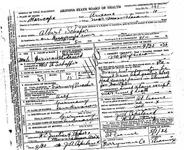Hinterlander wrote
This may be a beginner's question but... I've* been using the additional freetime that I seem to have nowadays to "go back to the basics" and reread both Sims Ely's book and the Bark Notes. Something that never really stood out to me before really caught my attention for some reason this time. On pages 87 & 88 of his book (my copy is the "Third Printing, April 1957"), Sims states "Helena Thomas (or Julia, as she is sometimes called in these apocryphal versions)" and "Helena was Mrs. Charles Thomas, not Mrs. J. E.". It had seemed to me that the common knowledge from everything else that I have read, including numerous books and posts on this and other forums, was that Julia was Julia who had been married to Emil W. Thomas. These men were contemporaries of Helena and interviewed her and Rheiny face to face multiple times to get to the facts of what Waltz had told them. It then hit me that if they couldn't get something as basic as her name and identity correct, what does that say for everything else in their books/manuscripts? Or, have we just skewed (and screwed) everything to fit our own narrative? Can anyone help enlighten me on this?
Ditto to what mi amigo Deducer said,
Welcome to the forum Sal!
I have to qualify this but yes - while it is generally best to stick with the oldest/closest to events/persons type of sources for your information, it is also necessary to keep in mind there are some severe limitations in those sources. Sims Ely had been a newspaperman, and in that day there was NO such thing as an internet to check and cross-verify any kind of information. Plus the bulk of the information he and ALL the other 'first' Dutch hunters had obtained came from what is today considered the ultimate worst possible type of sources - they got it by talking to people! (The horrors! Shudder!) This kind of source information is fraught with the possibilities for errors, exaggerations, and worse, deliberately misleading information. Some folks call that LIES.
To confound the problems, neither Sims Ely nor Jim Bark the assumed author of the Bark Notes, were actually prospectors. They did not even notice that the various stories they were accumulating as solid information about the Lost Dutchman's mine, really can't all be talking about the same mine or the same place! The ore descriptions for starters - one source has it as a rose quartz, another as a white quartz, and Apache Jack's gold ore was described as "black quartz with spots of gold like stars in the sky". Clearly these are not the same ore or the same mine! Even worse, they didn't apparently know the difference between lode gold (hard rock - still in the matrix) and placer, because they included the tale of the Mexican woman who remembered her husband "winnowing the pieces of gold out of the dirt like grains of wheat". This is a quite accurate description of how to dry-process a placer gold deposit by simply tossing it into the air on a blanket or gold pan in a stiff breeze, allowing the wind to carry away the lighter stuff and the gold falls onto the blanket or gold pan. It has nothing to do with a hard rock gold mine as Jacob Waltz must have had. I say must have had because he was seen by multiple witnesses selling hard rock gold ore, and the only specimens we have today that remain are the 'jewelry' which is online in multiple places, and one small piece the size of a hickory nut of which the whereabouts today I have no idea.
If you are serious about a search, yes DO turn back to the basics, and please also learn something of how to prospect for gold, look at as many different kinds of gold ore as you can, learn to pan (it is useful even for hard rock because you can crush the rock and pan out the gold) and some basic geology. Gold can occur almost anywhere (literally) but it is mostly found in certain kinds of rock - like quartz. Quartz is a secondary mineral, it is formed by superheated water that has lots of dissolved minerals in the water, that fills the cracks and voids in the rock that already existed in place. Hence the tendency for it to be found in 'veins' because of the similarity to veins, and some other rare forms like the 'chimney'. Anyway just keep in mind that while the oldest sources tend to be the best, you must keep the limitations in mind as well. Clearly several different lost mines have gotten mixed up together into an impossible legend of a gold mine, with an entrance like a giant funnel shaped pit, and an entrance hole no bigger than a barrel. It can't be both of those!
Good luck and good hunting Sal, I hope I have not discouraged you in any way.
Oroblanco
Coffee?













